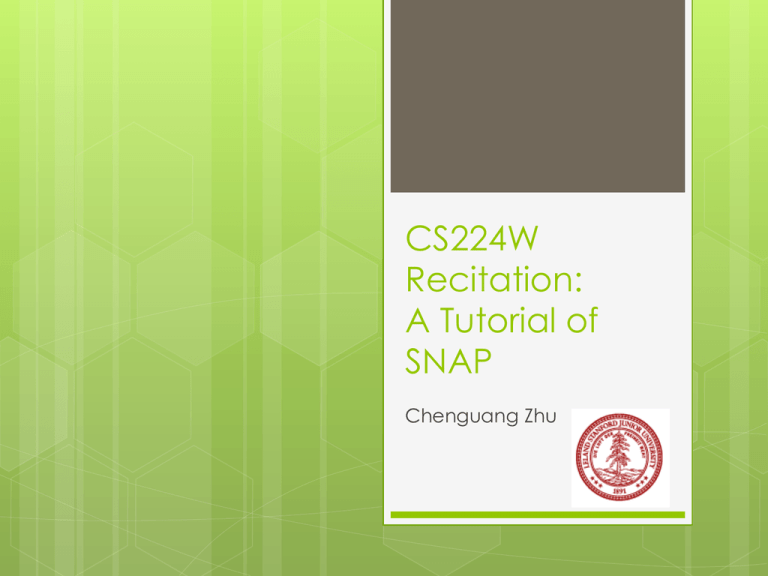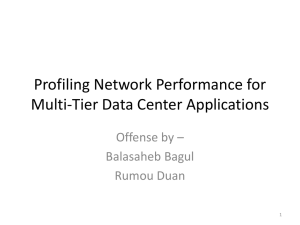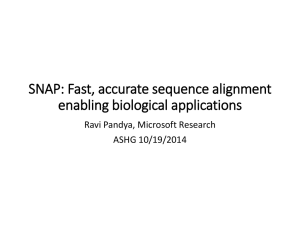SNAP Tutorial: Network Analysis with Stanford's Library
advertisement

CS224W
Recitation:
A Tutorial of
SNAP
Chenguang Zhu
What is SNAP?
Stanford
Network Analysis Project (SNAP)
A network analysis and graph mining
library
C++ based
Manipulates large graphs, calculates
structural properties, generates graphs,
and supports attributes on nodes and
edges
More info on http://snap.stanford.edu
Content
Installation
Data
structures in SNAP
Graph manipulation in SNAP
Datasets in SNAP
Plotting in SNAP
Q&A
Content
Installation
Data
structures in SNAP
Graph manipulation in SNAP
Datasets in SNAP
Plotting in SNAP
Q&A
Download
1.
Go to
http://snap.stanford.edu/snap/download.
html
2.
Download the latest SNAP version (v2.1)
Download
SNAP
Example (under Mac command line)
1.
Get git client
sudo port install git-core
2.
A
is also available from github
Clone the repository
git clone https://github.com/snapstanford/snap.git
snap folder will then be downloaded
with all the source code
Installation (Windows)
1.
Unzip
2. Go to subfolder “examples”
3. Open project “SnapExamples-VS10.sln”
(Visual Studio required)
Installation (Linux/Mac)
If
your system is Linux-based, use the Makefile
in the same folder
For
Mac, there’s snap-examples.xcodeproj for
Xcode.
You
can refer to any Makefile and Makefile.ex
in folders in “examples”, e.g.
examples/cascades
Where to run
Stanford
computing resources
http://itservices.stanford.edu/service/share
dcomputing/environments
ssh to corn.stanford.edu
No. of
Model
OS
Processor
Computers
30
Sun Blade Ubuntu 8-core 2.7
X6240 GNU/Linu GHz AMD
x
Opteron
(2384)
RAM
Disk
32 GB
10 GB
swap, 75
GB temp
Create Your Own Project
Open
Visual Studio and create a project
Create Your
Own Project (Windows)
Add
line “#include Snap.h” into your main
program
#include <stdio.h>
#include “Snap.h“
…
Include
YOUR_SNAP_PATH/snap-core/Snap.h &
Snap.cpp into your project
Add Path
Add
path to the Snap library code
YOUR-SNAP-PATH/glib-core
YOUR-SNAP-PATH/snap-core
YOUR-SNAP-PATH/snap-adv
Right-click
on your project and go to
“Properties”
Go to Configuration Properties C/C++
General Edit “Additional Include
Directories”
Create Your Own Project
Due
to the settings of SNAP, the character set
must be set to Multi-byte
Right-click on your project and go to “Properties”
Go to Configuration Properties General
Projects Defaults Character Set Select “Use
Multi-Byte Character Set”
Create Project under
Linux/Mac
Create a folder like myproj in the snap directory
(where snap-core, snap-adv .. are)
Write code, e.g. myproj.cpp, in myproj folder
Copy Makefile from tutorials folder to myproj folder,
change the definition of DEMOS to your code
name, e.g. DEMOS = myproj
Make
Content
Installation
Data
structures in SNAP
Graph manipulation in SNAP
Datasets in SNAP
Plotting in SNAP
Q&A
What’s In SNAP?
Data structures (In subfolder “glib-*”):
STL-like library
Contains basic data structures, like vectors,
hash-tables and strings
Provides serialization for loading and saving
Network analysis library (In subfolder “snap-*”)
Network generation, manipulation
Example
applications (In subfolder
“examples”)
Small sample applications that demonstrate
functionality
Data Structures
In subfolder “glib-core”
More info in glib-core/ds.h
Numbers:
Integers: TInt
Real number: TFlt
Example:
TInt a=5; cout<<a<<endl;
Note: in C style, use printf(“%d\n”, a.Val);
Basic Structures
String:
TStr
Examples:
TStr a="abc";
TStr b="ccc";
cout<<a.CStr()<<endl;
(char*) --- abc
cout<<a.Len()<<endl;
--- 3
cout<<a[0]<<endl;
--- a
cout<<(a==b)<<endl;
--- 0
Combination
Pair
TPair<Type1, Type2> (Type can also be complex
structures like TVec, TPair…)
E.g. TPair<TInt, TFlt> a; a.Val1=…; a.Val2=…;
List of shorthand (in ds.h)
typedef TPair<TInt, TInt> TIntPr;
typedef TPair<TInt, TIntPr> TIntIntPrPr;
Triple
TTriple<Type1, Type2, Type3>
Vectors
TVec<Type>
Example:
TVec<TInt> a;
a.Add(10);
a.Add(20);
a.Add(30);
cout<<a[0]<<endl;
--- 10
cout<<a.Len()<<endl; --- 3
Similarly, “Type” can be complex structures like
TVec< TVec< TVec<TFlt> > >
Hash Tables
THash<key
type, value type>
Key is the unique index, value is associated
with key
KeyId is index into the array that stores keyvalue pairs
Next (collision in hash)
KeyId
0
1
2
Key
“David”
“Ann”
“Jason”
Value
100
89
95
Hash Tables
Example:
THash<TInt, TStr> a;
a.AddDat(12, “abc”);
a.AddDat(34,“def”);
cout<<a.GetKey(0)<<endl;
---- 12
for (int i=0; i<2; ++i)
cout<<a[i].CStr()<<endl;
cout<<a.GetKeyId(12)<<endl;
---- abc
---- def
---- 0
cout<<a.GetDat(34).CStr()<<endl; ----- def
Hash Tables
When
key is of string type: THash<TStr, …>,
a more space-efficient way is to use
TStrHash<…>
Example: TStrHash<TInt>
Uses
string pool, saves more space
Hash Sets
In
case only key is needed, use THashSet
Example:
THashSet<TInt> a;
a.AddKey(12);
a.AddKey(34);
a.AddKey(56);
cout<<a.GetKey(2)<<endl;
--- 56
Saving and Loading
Binary
files
Much quicker to save/load
Memory efficient
Save:
{TFOut fout("a.bin");
a.Save(fout);}
Load:
{TFIn fin("a.bin");
a.Load(fin);}
Useful Data Structure(1): Time
TSecTm
Manipulates
time
Supports comparison, calculation in
different time units, obtaining current
time…
DEMO: demo-TSecTm.cpp
Useful Data Structure(2):
Generate Distribution
TRnd
class
Generate lots of distributions
Example:
TRnd a;
//exponential distribution
for (int i=0; i<10; ++i)
cout<<a.GetExpDev(1)<<endl;
DEMO:
demo-TRnd.cpp
Useful Data Structure(3):
Calculating Statistics
In
glib-core/xmath.h
Multiple classes
Calculating moments, correlation
coefficients, t-test …
Demo: demo-XMath.cpp
Content
Installation
Data
structures in SNAP
Graph manipulation in SNAP
Datasets in SNAP
Plotting in SNAP
Q&A
What’s In SNAP?
Data structures (In subfolder “glib-*”):
STL-like library
Contains basic data structures, like vectors, hashtables and strings
Provides serialization for loading and saving
•
Network analysis library (In subfolder “snap-*”)
Network generation, manipulation
Example
applications (In subfolder
“examples”)
Small sample applications that demonstrate
functionality
Graph Type
TUNGraph:
TNGraph:
undirected graph with no multi-edge
directed graph with no multi-edge
TNEGraph:
directed graph with multi-edge
Network Type
TNodeNet<TNodeData>:
directed graph
with TNodeData object for each node
TNodeEDatNet<TNodeData, TEdgeData>:
directed graph with TNodeData on each
node and TEdgeData on each edge
TNodeEdgeNet<TNodeData, TEdgeData>:
directed multi-edge graph with
TNodeData on each node and
TEdgeData on each edge
Network Type
TNodeNet<TNodeData>:
directed graph
with TNodeData object for each node
TNodeEDatNet<TNodeData, TEdgeData>:
directed graph with TNodeData on each
node and TEdgeData on each edge
TNodeEdgeNet<TNodeData, TEdgeData>:
directed multi-edge graph with
TNodeData on each node and
When you want to
TEdgeData on each edge
use saving/loading
function, you have to
write Save and Load
Demo: NodeNet.cpp
Example
Smart pointer: Count the
number of pointers to an object.
Release things automatically
when the count0
Use smart pointer whenever possible
typedef TPt<TNGraph> PNGraph
Add node before edges
Example:
PNGraph Graph = TNGraph::New();
Graph->AddNode(1);
Graph->AddNode(5);
Graph->AddEdge(1,5);
Example
Use smart pointer whenever possible
typedef TPt<TNGraph> PNGraph
Add node before edges
Example:
PNGraph Graph = TNGraph::New();
Graph->AddNode(1);
Graph->AddNode(5);
Graph->AddEdge(1,5);
Demo: demoGnm.cpp
Establish A Graph
Generate
graph with specific properties
Use TSnap::Gen…
TSnap::GenRndGnm
(Gnm (Erdős–Rényi) graph)
TSnap::GenForestFire (Forest Fire Model)
TSnap::GenPrefAttach (Preferential Attachment)
Example:
//
create a directed random graph on 100 nodes
and 1k edges
PNGraph Graph = TSnap::GenRndGnm<PNGraph>(100, 1000);
1.
Traverse a graph
// traverse the nodes
for (TNGraph::TNodeI NI=Graph->BegNI(); NI<Graph->EndNI(); NI++)
printf("%d %d %d\n", NI.GetId(), NI.GetOutDeg(), NI.GetInDeg());
// traverse the edges
for (TNGraph::TEdgeI EI=Graph->BegEI(); EI<Graph->EndEI(); EI++)
printf("edge (%d, %d)\n", EI.GetSrcNId(), EI.GetDstNId());
// we can traverse the edges also like this
for (TNGraph::TNodeI NI=Graph->BegNI(); NI<Graph->EndNI(); NI++)
for (int e = 0; e < NI.GetOutDeg(); e++)
printf("edge (%d %d)\n", NI.GetId(), NI.GetOutNId(e));
2.
Get properties of a graph
// generate a network using Forest Fire model
// convert to undirected graph TUNGraph
PUNGraph UG = TSnap::ConvertGraph<PUNGraph, PNGraph> (G);
// get largest weakly connected component of G
PNGraph G = TSnap::GenForestFire(1000, 0.35, 0.35);
PNGraph WccG = TSnap::GetMxWcc(G);
// get a subgraph induced on nodes {0,1,2,3,4}
PNGraph SubG = TSnap::GetSubGraph (G, TIntV::GetV(0,1,2,3,4));
Demo: demogetCC.cpp
Play With A Graph
TVec<TPair<TInt, TInt> > CntV; // vector of pairs of integers (size,
count)
//get distribution of connected components
(component size, count)
TSnap::GetWccSzCnt(G, CntV);
// get degree distribution pairs (degree, count)
TSnap::GetOutDegCnt(G, CntV);
More…
Explore
namespace TSnap
What’s In SNAP?
Data structures (In subfolder “glib-*”):
STL-like library
Contains basic data structures, like vectors, hashtables and strings
Provides serialization for loading and saving
•
Network analysis library (In subfolder “snap-*”)
Network generation, manipulation
Example
applications (In subfolder
“examples”)
Small sample applications that demonstrate
functionality
Example Applications
Cascades:
Simulate SI model on a
network
Cliques: Clique Percolation Method for
detecting overlapping communities
ForestFire: ForestFire graph generative
model
TestGraph: Demonstrates basic
functionality of the library
Content
Installation
Data
structures in SNAP
Graph manipulation in SNAP
Datasets in SNAP
Plotting in SNAP
Q&A
Datasets In SNAP
http://snap.stanford.edu/data/index.html
Some examples:
Social networks: online social networks, edges
represent interactions between people
Citation networks: nodes represent papers, edges
represent citations
Collaboration networks: nodes represent scientists,
edges represent collaborations (co-authoring a
paper)
Amazon networks : nodes represent products and
edges link commonly co-purchased products
Twitter and Memetracker : Memetracker phrases,
links and 467 million Tweets
Datasets in SNAP
Example file (as20graph.txt in subfolder examples)
# Directed Node Graph
# Autonomous systems (graph is undirected, each edge
is saved twice)
# Nodes: 6474 Edges: 26467
# SrcNId DstNId
1 3
1 6
1 32
1 48
1 63
1 70
…
Loading/Saving
Loading:
PUNGraph g=TSnap::LoadEdgeList<PUNGraph>(“as20graph.txt”,0,1);
0 is the column id for source node
1 is the column id for target node
Saving
TSnap::SaveEdgeList<PUNGraph>(g, “as20graph.txt”, ””);
Not as efficient as loading and saving in binary form
g->Save(TFOut(“graph.bin”));
Content
Installation
Data
structures in SNAP
Graph manipulation in SNAP
Datasets in SNAP
Plotting in SNAP
Q&A
Want To Draw?
Last
topic: making a plot in SNAP
Want To Draw?
Steps:
Install Gnuplot from http://www.gnuplot.info/
Make sure that the path containing
wgnuplot.exe (for Windows) or gnuplot (for Linux)
is in your environmental variable $PATH.
Example:
TVec<TPair<TFlt, TFlt > > XY1, XY2; …
TGnuPlot Gp(“file name”, “title name");
Gp.AddPlot(XY1, gpwLinesPoints, “curve1");
Gp.AddPlot(XY2, gpwPoints, “curve2");
Gp.SetXYLabel(“x-axis name", “y-axis name”);
Gp.SavePng(); //or Gp.SaveEps();
Gnuplot
After
executing, three files generated
.plt file is the plotting command for gnuplot
.tab file contains the data
.png or .eps is the plot
Demo: demoGnuplot.cpp
Visualize Your Graph
Use TGraphViz
Need to install GraphViz software first
http://www.graphviz.org/
Add GraphViz path to environment variable
Visualize graph with contents
PNGraph
g=TNGraph::New();
g->AddNode(1); g->AddNode(2);
g->AddNode(3); g->AddNode(4);
g->AddEdge(1,2); g->AddEdge(2,3);
g->AddEdge(1,3); g->AddEdge(2,4);
g->AddEdge(3,4);
TIntStrH name;
name.AddDat(1)="David";
name.AddDat(2)=“Rachel";
name.AddDat(3)="Jim";
name.AddDat(4)="Sam";
TSnap::DrawGViz<PNGraph>(g, gvlDot,
"gviz_plot.png", "", name);
Thank
Any
you!
questions?









